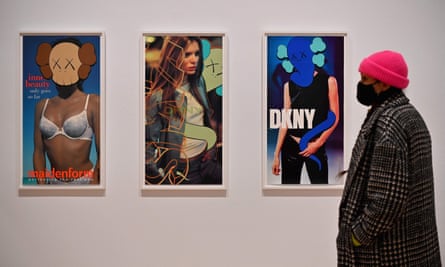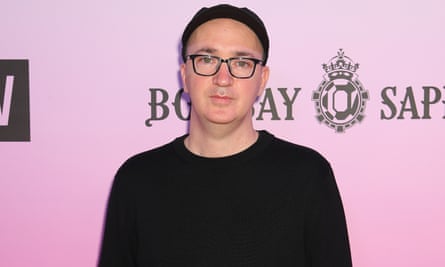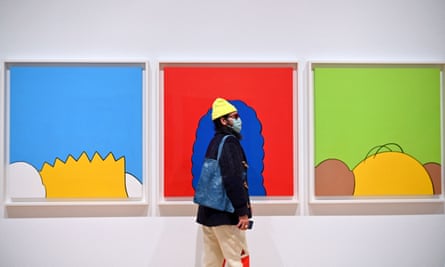In the spring of 2019, Brian Donnelly, better known for his artist moniker Kaws, was standing outside of the New York Academy of Art, ready to enter its annual party, the Tribeca Ball. The security guard refused to let him pass the velvet rope and enter the gala that was honoring him.
“That’s Kaws, he’s a famous artist,” a party guest told the security guard. The rope was eventually unlatched and Donnelly slinked in. He posed for photos, did a press interview, then sat down at a dinner table with the rapper and art collector Swizz Beatz.
Often when you are “art world famous”, not everyone recognizes you. And Donnelly is one of the most unfamous famous artists around.
But he’s finally getting a hometown retrospective at the Brooklyn Museum. More than 100 artworks are on view as part of Kaws: What Party, which runs until 5 September (by appointment).
With more than 3.3m Instagram followers, vinyl toys, fashion collaborations with Christian Dior, a top auction sale of $14.8m, the artist is already a pop culture phenomenon but despite the hype, he said in a past interview with the Guardian: “I wish the headlines were about the work.
“I was asked if I was ‘disappointed this exhibition is during the pandemic’, as there’s all these regulations,” he said, “but I think that could actually be a nice thing.”

It could potentially give more space to absorb the artwork. “For me, it’s a way to put the work I’ve been making for the past 20 or 25 years, and put it in front of people, and they’ll take from it what they can,” said Donnelly.
Indeed, it is an offline extravaganza (that will probably end up in a meta stream of online photos). “A lot of times, my work is only witnessed through print format, or online through jpgs, so this is a great opportunity to put original works in front of people.”
He has a studio in Williamsburg, wears sneakers and a snapback almost everywhere he goes and takes a backseat approach to interviews. Donnelly is apolitical, once saying: “I’m not trying to impose a way to feel about a work, I’m just sort of making the work and putting it into the world.”
He has a soft spot for the location of his new show. It was the first New York museum to acquire his artworks, a pair of wooden sculptures in the museum’s lobby called Along the Way.
He hopes this exhibition, too, inspires the next generation of artists. “It makes kids in Brooklyn know that there’s access, you can write your own script,” said Donnelly. “It gets you thinking beyond your 10-block radius.”

He includes early work in this exhibition that traces his roots, the sort of stuff that typically is not seen as high art today. “I’m happy I have sketch books and pictures of graffiti walls from the early 1990s in the show, so many people put that stuff away or say, ‘This is the point where I became a professional artist,’” he said. “But that whole time when I was painting walls and freight trains, that was painting. I was thinking about visual compositions in terms of color and scale, things I think about now.”
You won’t find Kaws dipping into a vocabulary of art jargon to explain his work. He doesn’t have an academic background and didn’t have his first exhibition until 2008. Donnelly, who is 46, grew up in Jersey City, got into skateboarding, became a graffiti artist and became a culture jammer in the 1990s, when he cranked open bus stop advertisements around New York City, to slide in his own paintings atop of fashion ads.
He got into animation work, then started designing toys, and is a top seller of collectible figurine dolls since his first vinyl toy with the Japanese clothing brand Bounty Hunter in 1999. He designed album art for Kanye West in 2008, which led to other commercial projects. He signals a shift in the art world – a hybrid artist bridging fine arts, commercial art and graphic design, as mainstream as he is meaningful.

Some of his best artworks are outdoors. He has created bold public art pieces, such as the Companion sculptures on a rooftop in China and a sculpture of his Companion figure laying back in the water in Victoria Harbor in Hong Kong for a 40ft-long inflatable piece called Kaws: Holiday. Last fall, his 20ft-tall bronze Chum character was plopped in front of the Ludwig Mies van der Rohe-designed Seagram building in New York.
“I’ve always felt public art was important,” said Donnelly. “To have that direct communication with the general public is really amazing.”
The curator Eugenie Tsai says Donnelly’s artwork is a reflection of our times. “Love, friendship, isolation, loneliness, it’s a symbol of our time,” said Tsai. “Today, these themes are more relevant than ever before.”
The exhibit starts with a life-sized pink sculpture of his Chum character, which is inspired by the Michelin Man, then goes into a room that shows his old notebooks, photos of his early graffiti tags. It segues into his 1990s ad-busting photos onto bus stop ads and shows a series of paintings featuring altered pop culture figures from The Simpsons, SpongeBob SquarePants, Snoopy and the Smurfs, all of which have X-ed out eyes.
In glass vitrines, there are countless figurines and toys (including his Kaws MTV Moonman from 2013, which was used for the MTV Video Music awards and held in the hands of winners like Justin Timberlake), as well as his designs for Comme des Garçons wallets and Vans sneakers.
But the exhibit really shines with the abstract paintings. Artworks like Mirror and Score Years take his cartoonish compositions to the next level. They elevate the post-anxiety ethos in his work beyond figurative form. His 2017 piece The News is an exercise in neon, retail-friendly color theory, laid out in the format of the graphic Instagram grid.

One groundbreaking piece is themed around his experience of getting Covid-19. The piece, entitled Urge (Kub2) was created in 2020, and details the artist’s interpretation of being in bed for three weeks with the virus. It shows his Chum character, having different colored paws over his torso and face, signifying “touching and contaminating”, said the artist.
Donnelly counts Claes Oldenburg as an influence. The pop artist, who saw his rise among Andy Warhol and Roy Lichtenstein in the 1960s, made enormous sculptures of everyday objects, like hamburgers, lipstick and a giant upside-down ice cream cone atop a building, it makes sense why.
“Claes Oldenburg has made many great public artworks, as well as smaller, more intimate objects and editions,” said Donnelly. “His use of scale to distort the viewers relationship to the work, as well as his choice of materials, was absolutely brilliant.”
The title of the exhibition, What Party, sounds like the anthem for 2021 (there are no parties anywhere, what party?). That phrase means something different to the artist today, just as it does to have an exhibition despite the state the world with the ongoing pandemic.
“What Party was originally the title of a sculpture I made in 2018, as I liked the uncertainty of it, and while seeing the sculpture take form, the title stuck,” he said.
“The timing somehow seems perfect even though we started planning it well before the pandemic. It feels like an accomplishment to organize and open an exhibition under these circumstances. I’m very thankful to my studio and everyone at the museum for the work they put in during these challenging times.”
Kaws: What Party runs at the Brooklyn Museum until 5 September (by appointment)
